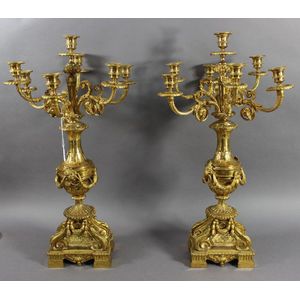Louis XVI Style Ormolu Candelabra - 19th Century
You must be a subscriber, and be logged in to view price and dealer details.
Subscribe Now to view actual auction price for this item
When you subscribe, you have the option of setting the currency in which to display prices to $Au, $US, $NZ or Stg.
- Ormolu - Ormolu was popular with French craftsmen in the 18th and 19th century for ornamental fittings for furniture, clocks and other decorative items. True ormolu is gilt bronze, that is bronze that has been coated with gold using a mercury amalgam. Due to the health risks associated with using mercury, this method of creating ormolu was discontinued in France in the 1830s. A substitute was developed consisting of about 75% copper and 25% zinc, however it was inferior to the bronze version. It was often lacquered to prevent it tarnishing.
- Capital - In architecture, a capital is the topmost member of a column, pilaster, or pier, which sits on top of the shaft and supports the entablature or architrave above it. The capital is typically the most ornate and decorative element of the column, and it can take many different forms depending on the architectural style of the building.
In classical architecture, the most common types of capitals are the Doric, Ionic, and Corinthian. Doric capitals are simple and have a circular shape with a flat top and bottom. Ionic capitals have a more elaborate design with scrolls or volutes (spiral shapes) at the top, and Corinthian capitals are the most decorative, with elaborate carvings of acanthus leaves and other motifs.
In other architectural styles, capitals can take many different forms, such as the bell-shaped capitals of Gothic architecture or the foliate designs of the Romanesque period. The capital is one of the most important architectural element in a building, it is the one that gives the most character and identity to the building. - Acanthus - A stylized leaf motif, one of the primary decorative elements of classical Greek and Roman architecture, derived from the genus of flowering plants in the family Acanthaceae, native to tropical and subtropical regions of the Mediterranean area. It is a common element in classical Greek and Roman design, and is often seen in Corinthian and Composite order columns and used as a decorative element in English, European and Australian furniture, particularly on the curve of a leg, and as decoration for a corbel.
This item has been included into following indexes:
- candelabra / candelabrum
Visually similar items

A pair of bronze candelabra supported on putti form columns, French, 19th century, 52 cm high

Pair of gilt bronze candlesticks, each in the form of an angel, with glass hurricane shades (2). Height 73 cm. Provenance: Robert Morrison Antiques

Impressive pair of antique French gilt bronze seven light candelabra, each, 67 cm high, (2)

WMF candelabrum having removable arms with three lights, removable drip pans & nozzles. Condition: good to fair, slight lean. Height 57 cm
